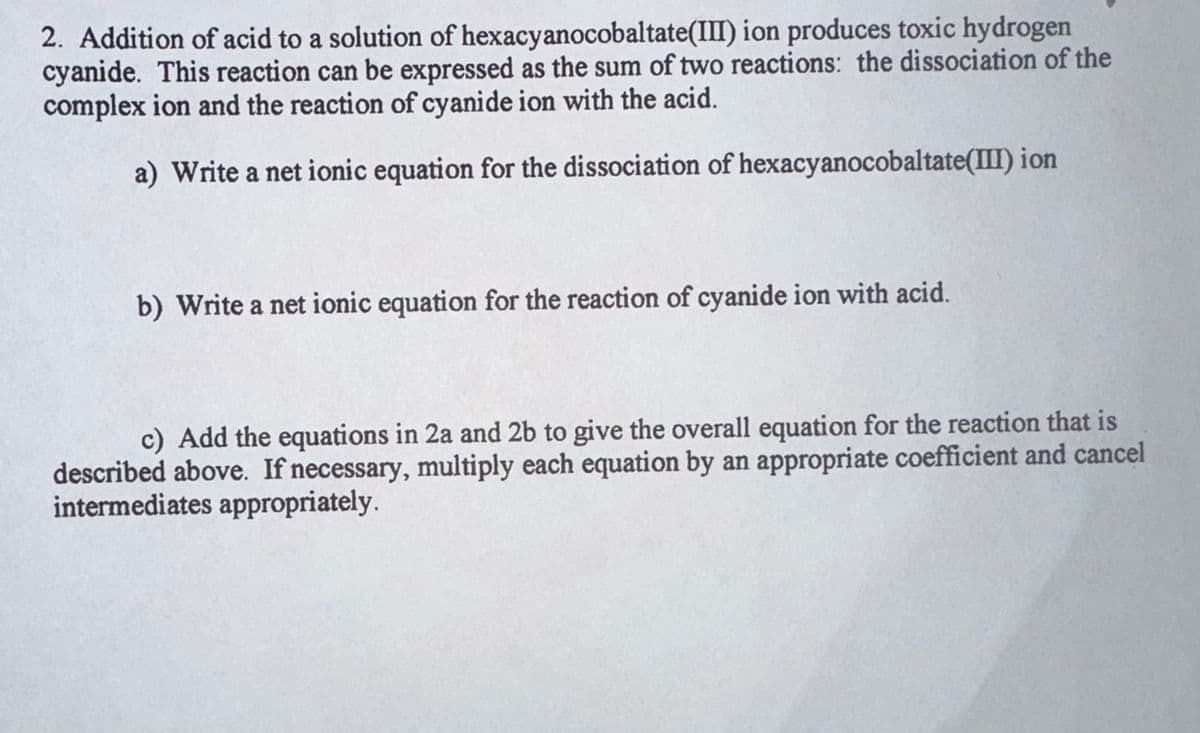ition of acid to a solution of hexacyanocobaltate(111) ion produces toxic hydrogen . This reaction can be expressed as the sum of two reactions: the dissociation of the Exion and the reaction of cyanide ion with the acid. a) Write a net ionic equation for the dissociation of hexacyanocobaltate(III) ion b) Write a net ionic equation for the reaction of cyanide ion with acid. c) Add the equations in 2a and 2b to give the overall equation for the reaction that is ped above. If necessary, multiply each equation by an appropriate coefficient and cancel
ition of acid to a solution of hexacyanocobaltate(111) ion produces toxic hydrogen . This reaction can be expressed as the sum of two reactions: the dissociation of the Exion and the reaction of cyanide ion with the acid. a) Write a net ionic equation for the dissociation of hexacyanocobaltate(III) ion b) Write a net ionic equation for the reaction of cyanide ion with acid. c) Add the equations in 2a and 2b to give the overall equation for the reaction that is ped above. If necessary, multiply each equation by an appropriate coefficient and cancel
Living By Chemistry: First Edition Textbook
1st Edition
ISBN:9781559539418
Author:Angelica Stacy
Publisher:Angelica Stacy
ChapterU1: Alchemy: Matter, Atomic Structure, And Bonding
SectionU1.8: What Goes Around Comes Around: Conservation Of Matter
Problem 5E
Related questions
Question
100%
What is the answer to A and B?

Transcribed Image Text:2. Addition of acid to a solution of hexacyanocobaltate(III) ion produces toxic hydrogen
cyanide. This reaction can be expressed as the sum of two reactions: the dissociation of the
complex ion and the reaction of cyanide ion with the acid.
a) Write a net ionic equation for the dissociation of hexacyanocobaltate(III) ion
b) Write a net ionic equation for the reaction of cyanide ion with acid.
c) Add the equations in 2a and 2b to give the overall equation for the reaction that is
described above. If necessary, multiply each equation by an appropriate coefficient and cancel
intermediates appropriately.
Expert Solution
This question has been solved!
Explore an expertly crafted, step-by-step solution for a thorough understanding of key concepts.
This is a popular solution!
Trending now
This is a popular solution!
Step by step
Solved in 2 steps with 1 images

Knowledge Booster
Learn more about
Need a deep-dive on the concept behind this application? Look no further. Learn more about this topic, chemistry and related others by exploring similar questions and additional content below.Recommended textbooks for you

Living By Chemistry: First Edition Textbook
Chemistry
ISBN:
9781559539418
Author:
Angelica Stacy
Publisher:
MAC HIGHER

Principles of Modern Chemistry
Chemistry
ISBN:
9781305079113
Author:
David W. Oxtoby, H. Pat Gillis, Laurie J. Butler
Publisher:
Cengage Learning

Chemistry & Chemical Reactivity
Chemistry
ISBN:
9781133949640
Author:
John C. Kotz, Paul M. Treichel, John Townsend, David Treichel
Publisher:
Cengage Learning

Living By Chemistry: First Edition Textbook
Chemistry
ISBN:
9781559539418
Author:
Angelica Stacy
Publisher:
MAC HIGHER

Principles of Modern Chemistry
Chemistry
ISBN:
9781305079113
Author:
David W. Oxtoby, H. Pat Gillis, Laurie J. Butler
Publisher:
Cengage Learning

Chemistry & Chemical Reactivity
Chemistry
ISBN:
9781133949640
Author:
John C. Kotz, Paul M. Treichel, John Townsend, David Treichel
Publisher:
Cengage Learning

Chemistry & Chemical Reactivity
Chemistry
ISBN:
9781337399074
Author:
John C. Kotz, Paul M. Treichel, John Townsend, David Treichel
Publisher:
Cengage Learning

Chemistry: Matter and Change
Chemistry
ISBN:
9780078746376
Author:
Dinah Zike, Laurel Dingrando, Nicholas Hainen, Cheryl Wistrom
Publisher:
Glencoe/McGraw-Hill School Pub Co

Chemistry by OpenStax (2015-05-04)
Chemistry
ISBN:
9781938168390
Author:
Klaus Theopold, Richard H Langley, Paul Flowers, William R. Robinson, Mark Blaser
Publisher:
OpenStax